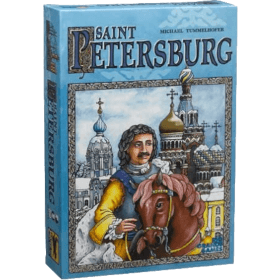Saint Petersburg
 Barokk paloták, széles körútok és elegáns hidak: Szentpétervár. Nagy Péter cár 1703. május 16-án lefekteti az első épület alapjait. Gyorsan lenyűgöző épületek emelkednek, amelyek egyre nagyobbak és szebbek. Az ilyen épületek hoznak az arisztokráciának dicsőségét és a játékosoknak győzelmi pontokat. Ehhez kereskedőkre van szükséged, hogy elhozzák a szükséges rubeleket ehhez a nagyszerűséghez, különben az épületek üresek és csupaszak. A verseny azonban soha nem pihen, és ellophatja a szükséges kártyákat közvetlenül az orrod elől.
Barokk paloták, széles körútok és elegáns hidak: Szentpétervár. Nagy Péter cár 1703. május 16-án lefekteti az első épület alapjait. Gyorsan lenyűgöző épületek emelkednek, amelyek egyre nagyobbak és szebbek. Az ilyen épületek hoznak az arisztokráciának dicsőségét és a játékosoknak győzelmi pontokat. Ehhez kereskedőkre van szükséged, hogy elhozzák a szükséges rubeleket ehhez a nagyszerűséghez, különben az épületek üresek és csupaszak. A verseny azonban soha nem pihen, és ellophatja a szükséges kártyákat közvetlenül az orrod elől.
Szent Petersburg: A gyönyörű Néva melletti élet kártyajátéka.
Játékosok száma: 2 - 4
Játékhossz: 13 mn
Bonyolultság: 2 / 5
Játssz Saint Petersburg-t és 1194 egyéb játékot!
Letöltés nem szükséges, közvetlenül a böngésződből játszható.
A barátaiddal és több ezer játékossal az egész világról.
Ingyenes.

Játssz Saint Petersburg-t és 1194 egyéb játékot!
Letöltés nem szükséges, közvetlenül a böngésződből játszható.
A barátaiddal és több ezer játékossal az egész világról.
Ingyenes.

Szabályösszefoglaló
St. Petersburg
The aim of the game is to gain as many victory points (shields) as possible.
Rules Summary
On Your Turn
On your turn, you may do one of four actions:
- Buy a card by paying the cost.
- Add a card to your hand. The hand limit is three.
- Play a card from your hand by paying the cost.
- Pass.
Phases
The game is made up of multiple rounds of 4 phases: workers, buildings, aristocrats, trade.
You buy cards for the number of rubles shown on the card.
If you already have one or more of the cards, they come at a discount and cost 1 ruble less for each card of the *same type* (but they always cost at least 1 ruble).
From the second round onwards, cards that were not used in the previous round are moved to the lower row - those cards cost 1 ruble less.
Worker Phase (Green Cards)
In this phase you buy worker cards.
At the end of the round, you are paid according to the number of rubles shown on each *green worker card* you have played.
Building Phase (Blue Cards)
In this phase building cards are used to fill up the empty spaces and you may buy any of the cards which are available.
At the end of the round, you score any points and gain any rubles which are shown on each *blue building card* you have played.
Aristocrat Phase (Red Cards)
In this phase aristocrat cards fill up the empty spaces and you may buy any of the cards which are available.
At the end of the round, you score any points and gain any rubles which are shown on each *red aristocrat card* you have played.
Trade Card Phase (Green/Blue/Red Cards)
In this phase trade cards fill up the empty spaces. The trade cards can be identified by the square around the cost number.
Playing trading cards:
- Blue trading cards can displace any already placed building.
- Red trading cards can displace any already placed aristocrat.
- Each green trading card must replace a specific type of worker (players can recognize pairs of green trading cards and their predecessor by matching symbols in the upper right of the cards):
- Carpenter Workshop - Lumberjack
- Gold Smelter - Gold Miner
- Weaving Mill - Shepherd
- Fur Shop - Fur Trapper
- Wharf - Ship Builder
- A trading card cannot displace another trading card.
Paying for trading cards:
- If trading card is more expensive than the card it displaces, the cost is the difference between the two.
- If trading card is the same cost or cheaper than the card it displaces, the cost is 1 ruble.
- All other normal cost reductions from other cards _do_ also apply to trading cards.
At the end of the Trade Card phase there is *no scoring*.
End of Round
At the end of the round, all cards on the lower row are discarded.
All cards remaining in the top row are moved to the lower row - these can then be bought for a reduction of 1 ruble.
Starting player markers are passed to the next player in turn order.
End of the game:
When the last card of any group (the last worker, the last building, the last aristocrat, or the last trading card) is placed on the board, play continues through all phases of that round. After that round ends, the game ends and the final scoring follows.
If there are not enough cards to fill the row, they place as many as they can and the rest of the spots are left empty.
You score additional points at the end for:
- Different types of aristocrats (see the scoring table)
- 1 point for every 10 rubles
- -5 point penalty for each card in hand
Scoring table
- 1 Aristocrat: 1 points
- 2 types of Aristocrats: 3 points
- 3 types of Aristocrats: 6 points
- 4 types of Aristocrats: 10 points
- 5 types of Aristocrats: 15 points
- 6 types of Aristocrats: 21 points
- 7 types of Aristocrats: 28 points
- 8 types of Aristocrats: 36 points
- 9 types of Aristocrats: 45 points
- 10+ types of Aristocrats: 55 points
If players tie, the one among them with the most money is the winner.

